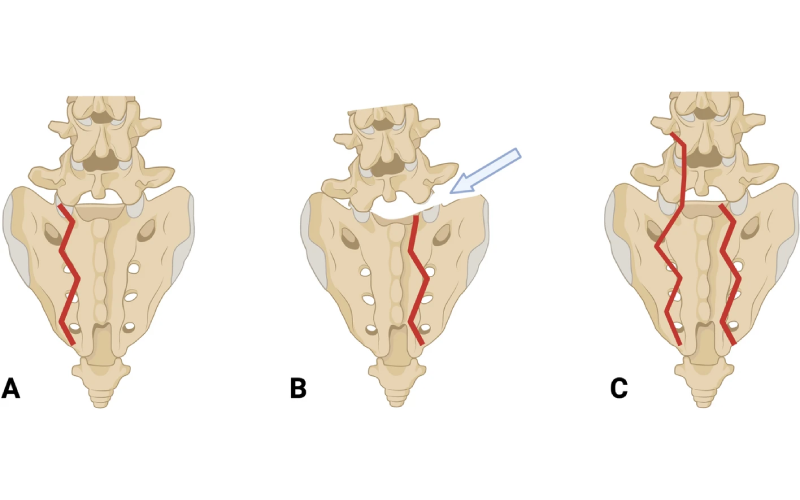The L5-S1 facet joint, a crucial intersecting point between the spine and the pelvis, is extremely important for weight-bearing throughout the entire body. Injuries to the facet joint can range from non-displaced fractures to severe fracture dislocations in the setting of a pelvic ring injury. The most common causes of these injuries are motor vehicle accidents, falls from height, and motorcycle crashes.
According to Nicholas C. Danford, MD, an orthopedic trauma surgeon at NewYork-Presbyterian and Columbia, L5-S1 injuries are often underrecognized and underreported. Dr. Danford and his colleagues recently initiated a study to characterize the pathology of L5-S1 facet joint injuries in the presence of pelvic ring injuries and determine the frequency of these injuries. Below, he discusses the study’s findings and implications for future research.
Research Background
Through our study, we sought to uncover whether an association exists between facet joint injuries and the type of pelvic ring injury. While anteroposterior compression and lateral compression are two types of pelvic ring fractures classified by the force that causes them, the association between each of these types of pelvic ring fractures and facet joint injuries is less obvious. Additionally, the very presence of a facet joint injury can be difficult to diagnose. If we could identify that facet joint injuries are seen in certain contexts, the findings could prompt physicians to consider the potential presence of these difficult-to-recognize injuries.

The Isler classification for L5-S1 facet joint injuries. Created with BioRender.com.
Prior to our research, smaller retrospective series indicated 6% to 19% of patients with a pelvic ring injury also have L5-S1 facet joint injuries. However, data is sparse on patient demographics and injury characteristics that may be associated with these injuries.
The first objective of our study, which was conducted in collaboration with colleagues at Harborview Medical Center in Seattle, focused on acquiring information that would describe L5-S1 injuries so that orthopedic traumatologists would have better insight in identifying and treating them. In addition, we wanted to explore the proportion of L5-S1 facet joint injuries not picked up during initial radiographic exams, which could obscure the actual prevalence of these injuries.
Research Methods
Our investigation drew on data of 476 patients 18 years and older who were treated for an acute pelvic ring injury at a single Level I Trauma Center between January 2019 and October 2022. The primary outcome variable was the presence of an L5-S1 facet joint injury defined as a fracture that extended into the L5 inferior or S1 superior facet, or an L5-S1 dislocation or fracture dislocation. Our team obtained information related to the CT view – axial, coronal, or sagittal – used for identifying the L5-S1 injury. For interobserver reliability, a spine surgeon classified 100 random pelvic injuries to confirm the involvement, if any, of an L5-S1 facet joint.
Research Findings
To our knowledge, this study is the first to define the prevalence of L5-S1 facet joint injuries in a large population. Of the 476 patients in the study, 53 or 11.9%had an L5-S1 facet joint injury. Thirty patients had either a non-displaced or minimally displaced L5 or S1 facet fracture. This data suggests that in the presence of certain pelvic ring injury patterns, orthopedic traumatologists and radiologists should evaluate the patient for an L5-S1 facet joint injury. These include any sacral fracture, Denis zone 2 and 3 fractures, bilateral displaced sacral fractures, and L5 transverse process fractures. Only 16%of radiology reports identified an L5-S1 injury. It is our recommendation, based on the study, that orthopedic traumatologists who treat pelvic ring injuries should assess the L5-S1 facet joint in the evaluation of every pelvis CT, especially in the context of certain sacral fracture patterns.
Our study is possibly the first to correlate pelvic ring and sacral fracture patterns with L5-S1 facet joint pathology and contributes to the scant existing literature on the topic.
— Dr. Nicholas Danford
Moving the Field Forward
With this study, we sought to draw attention to the L5-S1 facet joint in the context of pelvic ring injuries. Previous studies have offered little insight into the relationship of pelvic ring patterns to facet joint pathology. Determining optimal treatment strategies and assessing outcomes for facet injuries is an important subject for future research.
For many orthopedic injuries, only two radiographic views are needed. You know right away what's wrong, what to expect, and how to treat it. An L5-S1 facet joint injury certainly does not fit this scenario. While our overall sample size was large, the ultimate number of facet joint injuries was small, providing evidence that these are rare injuries. So our main takeaway is to be on the lookout for this injury, particularly when bilateral sacral fractures or other very serious sacral fractures are present. In these cases, it could be beneficial to obtain an opinion from a colleague (for example, a colleague trained in spine trauma) about both diagnosis and treatment.




